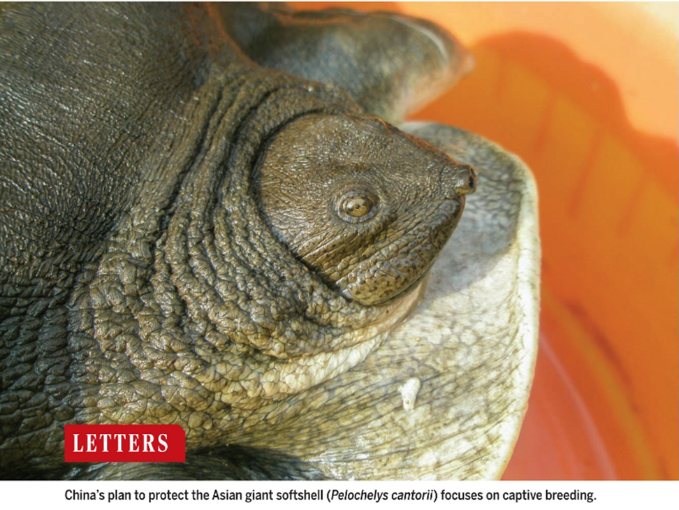
Chelonians are an important part of wildlife, and the effectiveness of their protection is closely related to the overall protection measures for wildlife. We have found that wildlife protection in China is plagued by problems such as multiple management, overlapping management departments and management areas, and other irrational institutional mechanism settings. However, the wildlife protection law focuses on utilization rather than protection, emphasizes on wildlife domestication and breeding rather than wild population protection, concentrates on the protection of rare and endangered species rather than the protection of ecosystems and ecological security. What’s worse, the national key wildlife protection list has not been revised for 32 years, during which time 33 species became extinct. The chelonians are the biggest victims of the ineffective protection of protected areas. Therefore, it is urgent to update the conservation concept of wildlife diversity in China, including chelonians, to rationalize the institutional mechanism, to strengthen the effectiveness of conservation management, and to promote the conservation of biodiversity and the construction of ecological civilization.
1. Integrated the protection of chelonians into the overall protection of wildlife. Discovered the problems in the institutional mechanism of wildlife protection, concept, legislation and management in China, and promoted its reform.
We found the misalignment of conservation concepts and initiatives, and promoted the investment of limited human, financial and material resources into the conservation of wild populations. We learned a lesson from the fact that Rafetus swinhoei, the large flagship species that was once widely distributed and abundant in China, has only one left, which points out the importance and urgency of wildlife population conservation, suggesting the reduction of the destruction of the original nature of natural habitats by the construction of hydroelectric power stations, etc., as well as the adoption of habitat restoration and protective salvage measures. The results were published in Science.
Figure China needs to protect turtles and tortoises in the wild (Science, 2021)
We have put forward advanced wildlife protection legislation and policy concepts, such as "protect all that should be protected and protect in an integrated manner", and have actively promoted the legislative protection of chelonians species. As industrious efforts have been made, the number of nationally protected chelonians species has increased from 35 per cent to 88 per cent, and the number of wild chelonians traded in the market has dropped by more than 98 per cent. Outstanding problems in the management system and laws and regulations of wildlife protection were analysed and revealed. Chelonians protection is embedded in the overall protection of wildlife, and the effect of overall protection directly affects the protection of chelonians.
Figure Integration and update of wildlife protection in China (Current Biology, 2020)
We proposed to consolidate the management of wildlife conservation and have an individual department be responsible for the protection and management of wildlife, and the department that manages the protected area should also manage the species therein. This reduced disputes over interests and shifting of responsibilities between departments. In terms of wildlife trade management, we suggest establishing a multi-departmental collaborative linkage mechanism to ensure management and enforcement efficiency. The results were published in Current Biology.
We also suggested that the Wildlife Conservation List, which is an important part of China's Wildlife Conservation Law, should be reviewed annually and updated in a timely manner, and a temporary replenishment mechanism should be established for those species in special circumstances. The inclusion of species in the list is the basic foundation for effective protection and law enforcement, so it is important to update the list in a timely manner according to the survival of the species. The results were published in Nature.
2. Found that the chelonians species is an ideal indicator species for monitoring the effectiveness of conservation. Revealed the root causes of the problem of poor conservation in protected areas.
The chelonians species was found to be an ideal indicator species for monitoring conservation effectiveness. Compared to other taxa, chelonians are highly valued and have poor escape abilities, which makes them ideal targets for hunting. Coupled with their weak reproductive capacity, chelonians will be the first victims if conservation is not effective. This finding is of great significance for the conservation of chelonians, which is the second most endangered vertebrate group, and is of great value in testing the effectiveness of the overall conservation of biodiversity.
We found that the number of chelonians in protected areas has declined by more than 80%, revealing the reasons for the ineffective protection of protected areas. Chelonians have suffered from long-term overhunting and habitat destruction, leading to a significant decline in the wild populations of all species of this taxon in China. Based on 12 years of survey data from 56 protected areas, we found that even the declines of Chelonians populations in protected areas exceeded 80%, reflecting the unscientific, imprecise and even supervisory problems in the management of China's protected areas, and contributing to the construction of the governance system and improvement of the governance capacity of the protected areas. The results were published in Current Biology.

Figure: Nature reserves fail to adequately protect endangered turtles and tortoises (Current Biology, 2017)

 中文
中文 English
English





